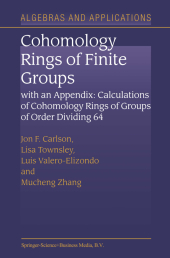 Neuerscheinungen 2010Stand: 2020-01-07 |
Schnellsuche
ISBN/Stichwort/Autor
|
Herderstraße 10
10625 Berlin
Tel.: 030 315 714 16
Fax 030 315 714 14
info@buchspektrum.de |

Jon F. Carlson, L. Townsley, Luís Valero-Elizondo
(Beteiligte)
Cohomology Rings of Finite Groups
With an Appendix: Calculations of Cohomology Rings of Groups of Order Dividing 64
Softcover reprint of the original 1st ed. 2003. 2010. xvi, 776 S. XV, 777 p. 235 mm
Verlag/Jahr: SPRINGER NETHERLANDS 2010
ISBN: 9048163854 (9048163854)
Neue ISBN: 978-9048163854 (9789048163854)
Preis und Lieferzeit: Bitte klicken
Group cohomology has a rich history that goes back a century or more. Its origins are rooted in investigations of group theory and num ber theory, and it grew into an integral component of algebraic topology. In the last thirty years, group cohomology has developed a powerful con nection with finite group representations. Unlike the early applications which were primarily concerned with cohomology in low degrees, the in teractions with representation theory involve cohomology rings and the geometry of spectra over these rings. It is this connection to represen tation theory that we take as our primary motivation for this book. The book consists of two separate pieces. Chronologically, the first part was the computer calculations of the mod-2 cohomology rings of the groups whose orders divide 64. The ideas and the programs for the calculations were developed over the last 10 years. Several new features were added over the course of that time. We had originally planned to include only a brief introduction to the calculations. However, we were persuaded to produce a more substantial text that would include in greater detail the concepts that are the subject of the calculations and are the source of some of the motivating conjectures for the com putations. We have gathered together many of the results and ideas that are the focus of the calculations from throughout the mathematical literature.
Preface. Acknowledgements.
1: Homological Algebra. 1. Introduction. 2. Complexes and Sequences. 3. Projective and Injective Models. 4. Resolutions. 5. Ext. 6. Tensor Products and Tor.
2: Group Algebras. 1. Introduction. 2. Duality and Tensor Products. 3. Induction and Restriction. 4. Radicals, Socles and Projective Modules. 5. Degree Shifting. 6. The Stable Category. 7. Group Cohomology and Change of Coefficients.
3: Projective Resolutions. 1. Introduction. 2. Minimal Resolutions. 3. The Bar Resolution. 4. Applications to Low Dimensional Cohomology. 5. Restrictions, Inflations and Transfers.
4: Cohomology Products. 1. Introduction. 2. Yoneda Splices and Compositions of Chain Maps. 3. Products and Group Algebras. 4. Restriction, Inflation and Transfer. 5. Cohomology Ring Computations. 6. Shifted Subgroups and Restrictions. 7. Automorphisms and Cohomology.
5: Spectral Sequences. 1. Introduction. 2. The Spectral Sequence of a Biocomplex. 3. Products. 4. The Lyndon-Hochschild-Serre Spectral Sequence. 5. Extension Classes. 6. Minimal Resolutions and Convergence. 7. Exact Couples and the Bockstein Spectral Sequence.
6: Norms and the Cohomology of Wreath Products. 1. Introduction. 2. Wreath Products. 3. The Norm Map. 4. Examples and Applications. 5. Finite Generation of Cohomology.
7: Steenrod Operations. 1. Introduction. 2. The Steenrod Algebra and Modules. 3. The Steenrod Operations on Cohomology. 4. Cohomology and Modules Over the Steenrod Algebra. 5. The Cohomology of Extraspecial 2-Groups. 6. The Cohomology of Extraspecial p-Groups. 7. Serre´s Theorem on the Vanishing of Bocksteins.
8: Varieties and Elementary Abelian Subgroups. 1. Introduction. 2. Filtrations on Modules. 3. Vanishing Products of Cohomology Elements. 4. Minimal Primes in Cohomology Rings. 5. The Stratification Theorem.
9: Cohomology Rings of Modules. 1. Introduction. 2. Generalized Bocksteins Over Elementary Abelian Groups. 3. Rank Varieties and Cohomology Rings Over Elementary Abelian Groups. 4. The Cohomological Support Variety of a Module. 5. Equating the Rank and Cohomological Support Varieties. 6. The Tensor Product Theorem. 7. Properties of the Cohomological Support Varieties.
10: Complexity and Multiple Complexes. 1. Introduction. 2. Notes on Dimension and Rates of Growth. 3. Complexity of Modules. 4. Varieties for Modules with Other Coefficient Rings. 5. Projective Resolutions as Multiple Complexes.
11: Duality Complexes. 1. Introduction. 2. Gaps in Cohomology. 3. Poincaré Duality Complexes. 4. Differentials in the HSS. 5. Cohen Macaulay Cohomology Rings. 6. Further Considerations.
12: Transfers, Depth and Detection. 1. Introduction. 2. Notes


